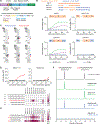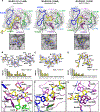Protective antibodies target cryptic epitope unmasked by cleavage of malaria sporozoite protein
- PMID: 39745947
- PMCID: PMC11804177
- DOI: 10.1126/science.adr0510
Protective antibodies target cryptic epitope unmasked by cleavage of malaria sporozoite protein
Abstract
The most advanced monoclonal antibodies (mAbs) and vaccines against malaria target the central repeat region or closely related sequences within the Plasmodium falciparum circumsporozoite protein (PfCSP). Here, using an antigen-agnostic strategy to investigate human antibody responses to whole sporozoites, we identified a class of mAbs that target a cryptic PfCSP epitope that is only exposed after cleavage and subsequent pyroglutamylation (pGlu) of the newly formed N terminus. This pGlu-CSP epitope is not targeted by current anti-PfCSP mAbs and is not included in the licensed malaria vaccines. MAD21-101, the most potent mAb in this class, confers sterile protection against Pf infection in a human liver-chimeric mouse model. These findings reveal a site of vulnerability on the sporozoite surface that can be targeted by next-generation antimalarial interventions.
Conflict of interest statement
Figures





References
-
- World Health Organisation, World malaria report 2023. https://www.who.int/teams/global-malaria-programme/reports/world-malaria... (2023).
-
- Sidjanski S, Vanderberg JP, Delayed migration of Plasmodium sporozoites from the mosquito bite site to the blood. Am J Trop Med Hyg 57, 426–429 (1997). - PubMed
-
- Boyd MF, Kitchen SF, The demonstration of sporozoites in human tissues. Am J Trop Med Hyg s1–19, 27–31 (1938).
-
- Amino R et al., Quantitative imaging of Plasmodium transmission from mosquito to mammal. Nat Med 12, 220–224 (2006). - PubMed
-
- Vanderberg JP, Frevert U, Intravital microscopy demonstrating antibody-mediated immobilisation of Plasmodium berghei sporozoites injected into skin by mosquitoes. Int J Parasitol 34, 991–996 (2004). - PubMed
Publication types
MeSH terms
Substances
Grants and funding
LinkOut - more resources
Full Text Sources
Other Literature Sources

